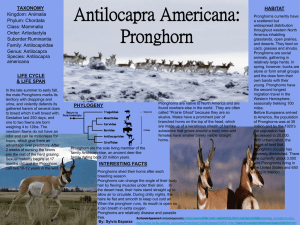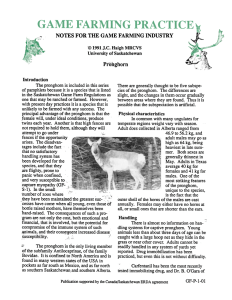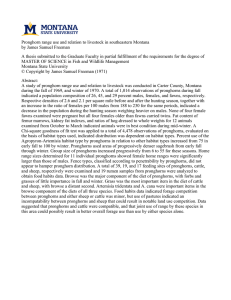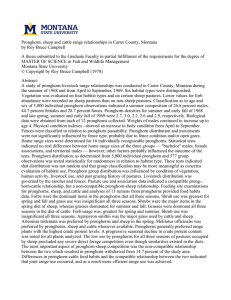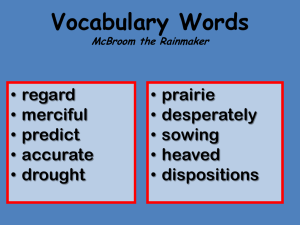Pronghorn Biology, Behavior, and Management
advertisement
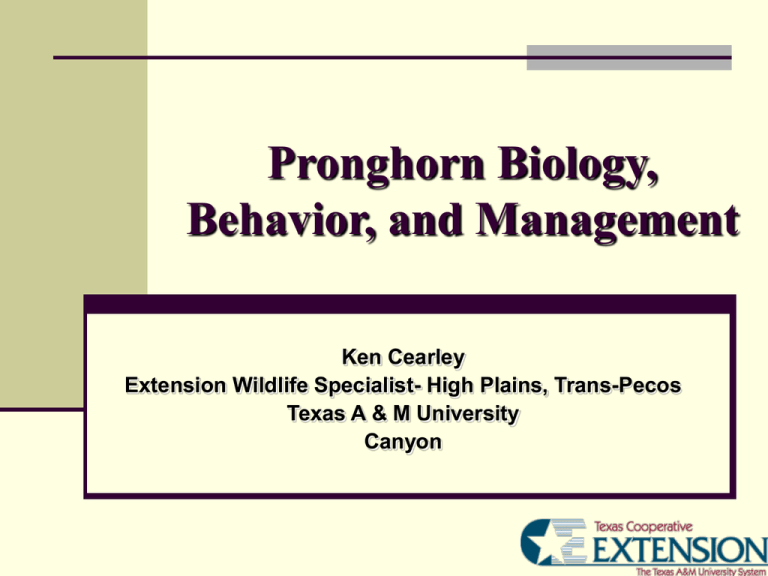
Pronghorn Biology, Behavior, and Management Ken Cearley Extension Wildlife Specialist- High Plains, Trans-Pecos Texas A & M University Canyon Objectives Overview of pronghorn basic life history Reproduction Behavior Pronghorn habitat requirements Management practices Emphasis on Panhandle Recommended Resources Pronghorn Ecology and Management. Bart W. O’Gara and Jim D. Yoakum. 2004. Common Rangeland Plants of the Texas Panhandle. NRCS. 2005. A Handbook for Pronghorn Antelope Management in Texas. Tommy Hailey, TPWD. 1986. Pronghorn Management Guide. R. E. Autenrieth, et al. 2006. Distribution of Pronghorns TPWD 1986 Trans-Pecos Pronghorns <12” precipitation typically Vegetation Grama grasslands Creosote-tarbush shrublands Tobosagrass Lower Plains Pronghorns ~16” precipitation Vegetation Bluestem Buffalograss Tobosagrass Mesquite Lotebush catclaw Panhandle Pronghorns High Plains 15-21 “ annual precipitation Mixed prairie Short-grass prairie Tall-grass prairie Vegetation Buffalograss Blue grama Mesquite Sand sage Shin oak Yucca Panhandle Pronghorns Rolling Plains 22-30” precipitation Tallgrass prairie Mid-grass prairie Vegetation Little bluestem Sand bluestem Sideoats grama Mesquite Sand sage Shin oak Description 70-140 lbs. Adult size by 2 years Does typically breed year two Both sexes horned Males have forked horns sheath shed annually Males have cheek/neck patch Abnormally large eyes Placement on skull beneficial Excellent eyesight Long legs- 45 plus mph Physiology Thermal regulation by counter-current blood flow to brain Cools blood supply Maximized airflow- by design Lungs Diaphragm Esophagus High hemoglobin concentration in blood Other design features Concentrated urine Water conserved by concurrent exchange of oxygen Water intake reduced by decreasing food intake in stressful / critical times Reproduction Breeding begins late summer Polygynous breeders Few males breed all adult females Resource-defense polygyny Resources clumped and predictable Female-defense polygyny Resources are evenly distributed and unpredictable Harems gathered Reproduction Breed as early as 16 months Breed annually until 8-10 years of age Rut onset varies with weather Photo-period driven, basically Length breeding season South- ~3 months North- ~ 3 weeks Does cycle until bred Reproduction 250 day gestation Nutrition during pregnancy and lactation critical 112:110 males to females at birth • Twinning common on healthy rangeland Food Habits Nutritional requirements Provision depends on availability Rainfall Competition Crop depredation Concentrate selectors Forbs- rank first in consumption, typically more nutrients, in small package Forbs high in water content Browse ranks second ~8 % of diet is grasses Water provided from free-standing, pre-formed, and metabolic processes Behavior Foraging affected by “build” Small frame Small organs Small mouth, muzzle Foraging affected by social behavior Behavior Herding Tighter as move north Selfish herds Predator avoidance Increases feeding efficiency White rump patch makes each individual highly visible TX- nomadic Farther north- more migratory Seasonal movements in response to habitat Most move less than 10-20 miles Restrictions to movement Fences ~18” clearance best; net wire restricts Highways Disease Implications Carriers of abortive diseases? Brucellosis? Leptosirosis? IBR? 10 years of sampling by TPWD 1060-1970 N=827 No brucellosis No lepto N=75 IBR 5 false positives, end result- no IBR Management Inventory Aerial Mid to late summer, usually Strip flying Some important parameters Total count Doe:Fawn ratio Exceptional animals Overall range and animal condition Management Harvest Permit issuance determined by TPWD Surplus taken if necessary to maintain carrying capacity Parameters Age 4 1/3 years+ best horns 1:2 buck:doe ratio conducive 1:4 more conducive to larger number young animals Habitat conditions Carrying capacity Objectives and goals Aging Pronghorns Fawns Short jaw length Molars not fully erupted Yearling 1 yr 4 mos TPWD Aging Pronghorns 2 yrs 4 mos TPWD Aging Pronghorns 3 yrs 4 mos TPWD Aging Pronghorns 4 yrs 4 mos TPWD Aging Pronghorns ~8 yrs 4 mos TPWD Management Keep watering facilities functional Maintain range condition to provide adequate food supply Fawning cover Thwarts predation efforts Adequate nutrition Especially during spring and summer when peak demands from gestation, then lactation Management Provide unrestricted movement Pronghorn friendly fencing Management Deter crop depredation Management Supplemental feeding May be beneficial in nutritionally stressful periods Feed not readily accepted Summary Inventory Plan the harvest TPWD determines permit issuance Monitor range condition and pronghorn condition to determine carrying capacity Maintain water even when livestock not present, including breaking ice Fencing conducive to goals Restriction or movement Age determination of harvested animals Utilize supplemental feeding as required Manage predators when necessary (coyotes primarily) Maintain good range condition to provide physical protection (thermal, predation) and food requirements.

